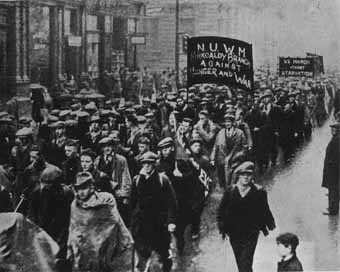| Seventy-five years ago this month the Great Crash occurred on the world's stock markets, precipitating mass unemployment, heightened exploitation, and war. Has capitalism really changed since then? |
the day the markets died
WORKERS, OCT 2004 ISSUE
Unemployed workers setting out from Glasgow to march to London in 1934. Mass unemployment throughout the industrial world (apart from Russia) followed the Crash. The great crash of 1929 happened 75 years ago this month. Despite its claims, one wonders whether capitalism has really changed all that much.
The 1920s in the USA were years of bull markets, marked by ruthless greed and reckless euphoria. Investors, fuelled by bank and broker loans, herded into stocks of companies involved in exciting new technologies like the radio and mass electrification.
The bull market - especially in issues of public utilities - was driven by mergers, new groupings and corporate buying for employee stock funds. Later, The Saturday Review bemoaned "the avarice of an era that favoured the rich; and the later anguish of myriads of speculators doomed by a bloated market, easy credit, and their own cupidity and stupidity".
Forgery
The crash had its own Enrons and World.coms. For example, Clarence Hatry and his associates admitted to forging the accounts of their investment group to show a fake net worth of £24 million, rather than the true picture of £19 million debts. This led to forced liquidation of Wall Street positions by British financiers. The collapse of Middle West Utilities, run by the energy tycoon, Samuel Insull, exposed a web of offshore holding companies whose only purpose was to hide losses and disguise leverage. Richard Whitney, the aristocratic Morgan broker and head of the Stock Exchange, ended up in Sing Sing, the New York jail.
Inequality skyrocketed, due to great and growing exploitation. While output per man-hour shot up by 32% between 1923 and 1929, wages crept up only 8%. In 1929, the richest 0.1% of the population earned as much as the poorest 42%. Business-friendly administrations reduced by 70% the taxes paid by those with an income of more than $1 million. But in the summer of 1929, businesses reported sharp increases in inventories: workers were too poor to buy the goods they produced. In June, industrial production, steel production and homebuilding all fell.
The crash was there waiting to happen, but finally set in motion by actions of the US Federal Reserve and the Governor of the Bank of England. Starting in 1928, the Federal Reserve initiated a sharp reversal of its reflationary, "cheap money" policies which had been intended, as Adolph Miller of the Fed's Board of Governors told a Senate committee, to start an outflow of gold - to reverse the previous inflow of gold into the US (back to Britain). But by the time the Fed raised interest rates, it had already lost control of the speculative rush.
Webster Tarpley wrote in his BRITISH FINANCIAL WARFARE: "When this Wall Street Bubble had reached gargantuan proportions in the autumn of 1929, Montagu Norman [governor of the Bank of England 1920-1944] sharply [upped] the British bank rate, repatriating British hot money, and pulling the rug out from under the Wall Street speculators, thus deliberately and consciously imploding the US markets.
"This caused a violent depression in the United States and some other countries, with the collapse of financial markets and the contraction of production and employment. In 1929, Norman engineered a collapse by puncturing the bubble."
On 24 October the panic began: more than 12 million shares were sold that day; on 29 October, 16 million. The Wall Street meltdown destroyed savings, investment and jobs.
From 1930 to 1940, there were never fewer than eight million American workers unemployed. In 1933, thirteen million, a quarter of all workers, were jobless; in 1938, it was still a fifth. Right up to 1941, the value produced was less than before the Crash. The famed New Deal never succeeded in ending the slump. Only the Second World War pulled capitalism out of self-induced disaster.
Soviet success
In a global economy, disaster in the USA caused disaster across the world, with one exception, the Soviet Union, where they were a year into their first Five Year Plan, successfully building a world independent of the greed and follies of a capitalism in absolute decline. In every other country, the ruling class attacked the working class, axing jobs, production and wages.
Today's stock markets again see speculation and rising prices. Finance capital sucks the life out of the system, siphoning collectively produced wealth into private pockets. Capitalism is ever less able to produce goods and raise living standards. Capacity to produce far outstrips production, which in turn far outstrips consumption.
Current earnings cannot cover current needs, leading to ever-higher national, government and household debts and vulnerability (Britain's personal indebtedness now totals £1 trillion).
Since March 2001, about $5 trillion of market capitalisation in the Nasdaq market for shares in hi-tech firms, has just vanished. Yet delusions still prevail: Federal Reserve Chairman Alan Greenspan told Congress this summer, "While bubbles that burst are scarcely benign, the consequences need not be catastrophic for the economy." How long before the balloon pops and the economy deflates?
